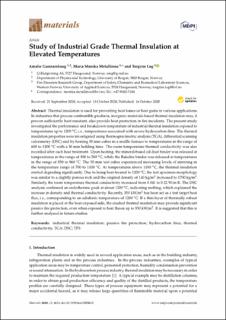| dc.contributor.author | Gunnarshaug, Amalie | |
| dc.contributor.author | Log, Maria-Monika Metallinou | |
| dc.contributor.author | Log, Torgrim | |
| dc.date.accessioned | 2020-11-30T12:54:38Z | |
| dc.date.available | 2020-11-30T12:54:38Z | |
| dc.date.created | 2020-10-20T21:49:20Z | |
| dc.date.issued | 2020 | |
| dc.identifier.citation | Gunnarshaug, A., Metallinou, M. M., & Log, T. (2020). Study of industrial grade thermal insulation at elevated temperatures. Materials, 13(20). | en_US |
| dc.identifier.issn | 1996-1944 | |
| dc.identifier.uri | https://hdl.handle.net/11250/2690230 | |
| dc.description.abstract | Thermal insulation is used for preventing heat losses or heat gains in various applications. In industries that process combustible products, inorganic-materials-based thermal insulation may, if proven sufficiently heat resistant, also provide heat protection in fire incidents. The present study investigated the performance and breakdown temperature of industrial thermal insulation exposed to temperatures up to 1200 ◦C, i.e., temperatures associated with severe hydrocarbon fires. The thermal insulation properties were investigated using thermogravimetric analysis (TGA), differential scanning calorimetry (DSC) and by heating 50 mm cubes in a muffle furnace to temperatures in the range of 600 to 1200 ◦C with a 30 min holding time. The room temperature thermal conductivity was also recorded after each heat treatment. Upon heating, the mineral-based oil dust binder was released at temperatures in the range of 300 to 500 ◦C, while the Bakelite binder was released at temperatures in the range of 850 to 960 ◦C. The 50 mm test cubes experienced increasing levels of sintering in the temperature range of 700 to 1100 ◦C. At temperatures above 1100 ◦C, the thermal insulation started degrading significantly. Due to being heat-treated to 1200 ◦C, the test specimen morphology was similar to a slightly porous rock and the original density of 140 kg/m3 increased to 1700 kg/m3. Similarly, the room temperature thermal conductivity increased from 0.041 to 0.22 W/m·K. The DSC analysis confirmed an endothermic peak at about 1200 ◦C, indicating melting, which explained the increase in density and thermal conductivity. Recently, 350 kW/m2 has been set as a test target heat flux, i.e., corresponding to an adiabatic temperature of 1200 ◦C. If a thin layer of thermally robust insulation is placed at the heat-exposed side, the studied thermal insulation may provide significant passive fire protection, even when exposed to heat fluxes up to 350 kW/m2. It is suggested that this is further analysed in future studies. | en_US |
| dc.language.iso | eng | en_US |
| dc.publisher | MDPI | en_US |
| dc.rights | Navngivelse 4.0 Internasjonal | * |
| dc.rights.uri | http://creativecommons.org/licenses/by/4.0/deed.no | * |
| dc.subject | industrial thermal insulation | en_US |
| dc.subject | passive fire protection | en_US |
| dc.subject | hydrocarbon fires | en_US |
| dc.subject | thermal conductivity | en_US |
| dc.subject | TGA | en_US |
| dc.subject | DSC | en_US |
| dc.subject | TPS | en_US |
| dc.title | Study of Industrial Grade Thermal Insulation at Elevated Temperatures | en_US |
| dc.type | Peer reviewed | en_US |
| dc.type | Journal article | en_US |
| dc.description.version | publishedVersion | en_US |
| dc.rights.holder | © 2020 by the authors | en_US |
| dc.source.pagenumber | 16 | en_US |
| dc.source.volume | 13 | en_US |
| dc.source.journal | Materials | en_US |
| dc.source.issue | 20 | en_US |
| dc.identifier.doi | 10.3390/ma13204613 | |
| dc.identifier.cristin | 1841039 | |
| dc.relation.project | Norges forskningsråd: 305336 | en_US |
| cristin.ispublished | true | |
| cristin.fulltext | original | |
| cristin.qualitycode | 1 | |

